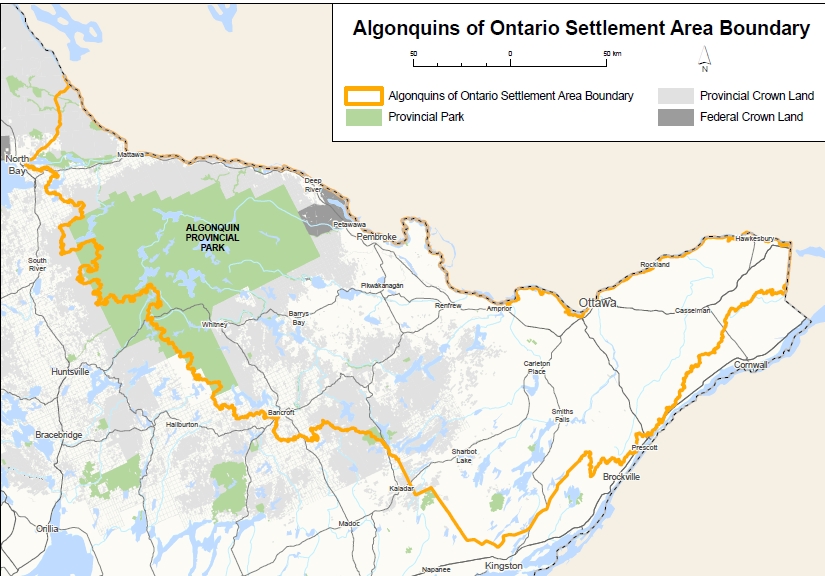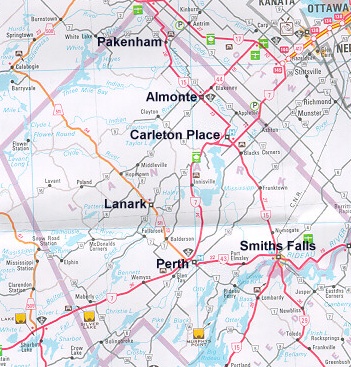The Valley of the Kiji Sibi
 The Ottawa valley is homeland to the Omamiwinini – Algonquin people who have inhabited this land for 10,000 years. When people came from other lands first to explore and to trade with Indigenous Peoples and then eventually to settle here, Algonquin people welcomed and befriended them and indeed assisted them to survive in difficult conditions. Despite the Royal Proclamation of 1763 and the Treaty of Niagara in 1764 between First Nations and the Crown that required agreement on both parts for any of the land to be sold to settlers, settlers gradually took over the land, pushing Algonquin people aside with no regard for their cultural, material or spiritual needs or of the land that sustained them. Lanark County, where we live continues today, is unceded Algonquin territory. Currently Algonquin people of Ontario are working with the federal government on a Land Claim Agreement. There is now a proposal on the table but some Algonquin people are not yet satisfied with the terms.
The Ottawa valley is homeland to the Omamiwinini – Algonquin people who have inhabited this land for 10,000 years. When people came from other lands first to explore and to trade with Indigenous Peoples and then eventually to settle here, Algonquin people welcomed and befriended them and indeed assisted them to survive in difficult conditions. Despite the Royal Proclamation of 1763 and the Treaty of Niagara in 1764 between First Nations and the Crown that required agreement on both parts for any of the land to be sold to settlers, settlers gradually took over the land, pushing Algonquin people aside with no regard for their cultural, material or spiritual needs or of the land that sustained them. Lanark County, where we live continues today, is unceded Algonquin territory. Currently Algonquin people of Ontario are working with the federal government on a Land Claim Agreement. There is now a proposal on the table but some Algonquin people are not yet satisfied with the terms.
In our area –that is, Lanark County – there are no reserves. In the south-western corner is the Shabot Lake band. This band also has an office in the White Lake area. To the north of us in Renfrew County, is the Pikwakanagan reserve. The government, as part of the Land Claim Agreement, is offering Algonquin people first right of refusal on purchase of Crown Land at White Lake and the buildings that belong to a third party with conditions. There are also a significant number of people with Indigenous heritage living in Lanark County; some who are doing well and some who are not.
Plenty Canada
 However, we are fortunate that Plenty Canada is located in Lanark County:
However, we are fortunate that Plenty Canada is located in Lanark County:
Plenty Canada is a registered non-profit organization that facilitates access to and shares resources with Indigenous peoples and other community groups around the world in support of their environmental protection and sustainable development goals.
At Plenty Canada we recognize that people are part of the environment and we sustain healthy lives only when the environment as a whole is healthy. For us the environment and the bio-diversity of our environment is a precious treasure we need to protect.
Larry McDermott, Algonquin Ambassador and knowledge keeper, is CEO of Plenty Canada, is well aware of the fact that here in Lanark County, despite the exploitation of the land over the past 200 years, we still have some natural heritage systems that need protection.
The Mississippi Valley Field Naturalists describe it as:
an ecologically based delineation of nature and natural function – a system of connected or to be connected green and natural areas that provide ecological functions over a longer period of time and enable movement of species. Natural heritage systems encompass or incorporate natural features, functions and linkages (also referred to as ‘corridors’) as component parts within them and across the landscape. They also enable the linking of different landscapes.
In sum, right here we have both challenges to face and a wonderful opportunity for renewing friendships based on a shared concern for the future of the land, shaped by the teachings embedded in the phrase: All My Relations.
